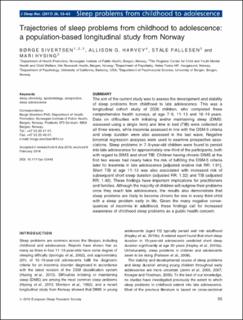| dc.contributor.author | Sivertsen, Børge | |
| dc.contributor.author | Harvey, Allison G | |
| dc.contributor.author | Pallesen, Ståle | |
| dc.contributor.author | Hysing, Mari | |
| dc.date.accessioned | 2020-12-15T13:43:44Z | |
| dc.date.available | 2020-12-15T13:43:44Z | |
| dc.date.created | 2016-10-13T12:51:39Z | |
| dc.date.issued | 2016 | |
| dc.identifier.citation | Journal of Sleep Research. 2016, 26 (1), 55-63. | en_US |
| dc.identifier.issn | 0962-1105 | |
| dc.identifier.uri | https://hdl.handle.net/11250/2719598 | |
| dc.description.abstract | The aim of the current study was to assess the development and stability of sleep problems from childhood to late adolescence. This was a longitudinal cohort study of 2026 children, who completed three comprehensive health surveys, at age 7–9, 11–13 and 16–19 years. Data on difficulties with initiating and/or maintaining sleep (DIMS: assessed using a single item) and time in bed (TIB) were collected at all three waves, while insomnia assessed in line with the DSM‐5 criteria and sleep duration were also assessed in the last wave. Negative binomial regression analyses were used to examine prospective associations. Sleep problems in 7–9‐year‐old children were found to persist into late adolescence for approximately one‐third of the participants, both with regard to DIMS and short TIB. Children having chronic DIMS at the first two waves had nearly twice the risk of fulfilling the DSM‐5 criteria later for insomnia in late adolescence [adjusted relative risk RR: 1.91]. Short TIB at age 11–13 was also associated with increased risk of subsequent short sleep duration (adjusted RR: 1.32) and TIB (adjusted RR: 1.40). These findings have important implications for practitioners and families. Although the majority of children will outgrow their problems once they reach late adolescence, the results also demonstrate that sleep problems are likely to become chronic for one in every third child with a sleep problem early in life. Given the many negative consequences of insomnia in adulthood, these findings call for increased awareness of childhood sleep problems as a public health concern. | en_US |
| dc.language.iso | eng | en_US |
| dc.title | Trajectories of sleep problems from childhood to adolescence: a population-based longitudinal study from Norway | en_US |
| dc.type | Peer reviewed | en_US |
| dc.type | Journal article | en_US |
| dc.description.version | publishedVersion | en_US |
| cristin.ispublished | true | |
| cristin.fulltext | original | |
| cristin.qualitycode | 1 | |
| dc.identifier.doi | 10.1111/jsr.12443 | |
| dc.identifier.cristin | 1391480 | |
| dc.source.journal | Journal of Sleep Research | en_US |
| dc.source.volume | 26 | en_US |
| dc.source.issue | 1 | en_US |
| dc.source.pagenumber | 55-63 | en_US |
